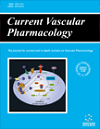- Home
- A-Z Publications
- Current Vascular Pharmacology
- Previous Issues
- Volume 9, Issue 4, 2011
Current Vascular Pharmacology - Volume 9, Issue 4, 2011
Volume 9, Issue 4, 2011
-
-
Pleiotropic Effects of Nicotinic Acid: Beyond High Density Lipoprotein Cholesterol Elevation
More LessAims: Treatment with statins has significantly reduced cardiovascular morbidity and mortality, an effect attributed to both the low-density lipoprotein cholesterol (LDL-C) lowering capacity and the pleiotropic actions of these drugs. However, residual risk remains even after intense LDL-C lowering. Therefore, additional treatment with lipid-lowering drugs which improve other lipid parameters and have favourable non-lipid Read More
-
-
-
Gene-Lifestyle and Gene-Pharmacotherapy Interactions in Obesity and Its Cardiovascular Consequences
More LessAuthors: Paul W. Franks and Alaitz PovedaObesity is a highly prevalent complex trait that raises the risk of other chronic diseases such as type 2 diabetes, certain cancers, sleep apnea, and cardiovascular disease, and shortens lifespan. Clinical intervention studies focused on weight loss and epidemiological studies of obesity indicate that genetic variation may modify the relationship between lifestyle behaviors and weight loss or weight gain. Similar observations have Read More
-
-
-
Pulmonary Hypertension: Role of Combination Therapy
More LessAuthors: Tobias Meis and Juergen BehrOver the past decade different effective treatment options for use in pulmonary arterial hypertension (PAH) have been developed. Due to multiple pathophysiological pathways in PAH and unsatisfactory overall results with the use of monotherapy in a substantial number of PAH patients, there is a pharmacological rationale for combination therapy. The currently approved substances target the prostacyclin, the endothelin and the Read More
-
-
-
Atherosclerotic Renal Artery Stenosis: An Update on Diagnosis and Management
More LessAtherosclerotic renal artery stenosis (ARAS) is a progressive disease and it is usually associated with hypertension as well as with chronic kidney and cardiovascular disease. Although the anatomical lesions are relatively easy to depict, there is need to identify diagnostic methods to establish the functional significance of the stenosis and predict the response to revascularization. Over the last years, renal revascularization appears Read More
-
-
-
Doxycycline Inhibition of Abdominal Aortic Aneurysm Growth - A Systematic Review of the Literature
More LessAuthors: Benjamin R. Dodd and Roy A. SpenceAbdominal aortic aneurysm (AAA) is a common disease and a major cause of death through rupture, the risk of which increases with aneurysm size. There is approximately a 5 year interval from when aneurysmal dilatation develops until it reaches a size where surgery is indicated. Slowing, or arresting, aneurysm growth during this period would be beneficial. Aneurysmal aortic wall degeneration is a multifactorial, chronic inf Read More
-
-
-
Platelet Function and Antiplatelet Therapy in Cardiovascular Disease: Implications of Genetic Polymorphisms
More LessAuthors: Jayashree Shanker, Armen Yuri Gasparyan, George D. Kitas and Vijay V. KakkarPlatelets play a crucial role in thrombosis, inflammation, immunity and atherogenesis. Antiplatelet agents are widely used in patients with acute coronary syndrome and other cardiovascular disorders. Aspirin and clopidogrel are the most commonly prescribed antiplatelet agents, with a relatively safe profile and efficiency in a variety of clinical conditions. Numerous prospective studies have revealed variability of antiplate Read More
-
-
-
Microparticles in Health and Disease: Small Mediators, Large Role?
More LessMicroparticles are circulating fragments derived from blebbing and shedding of cell membranes through several mechanisms that include activation, apoptosis and cell damage. In the past they were largely considered as unimportant cell “dust”, but more refined detection techniques have revealed large variations in their relative proportion and concentration in numerous disease states. Importantly, these conditions i Read More
-
-
-
Pharmacology of the Human Saphenous Vein
More LessNowadays, the great saphenous vein is the vascular conduit that is most frequently employed in coronary and peripheral revascularization surgery. It is known that saphenous vein bypass grafts have shorter patency than arterial ones, partly because the wall of the normal saphenous vein has different structural and functional characteristics. The features of this vein can be affected by the large distention pressures it is submitt Read More
-
-
-
What Restricts the Clinical Use of Nicotinic Acid?
More LessAuthors: Anastazia Kei, Evangelos N. Liberopoulos and Moses S. ElisafNicotinic acid is the oldest hypolipidemic agent in use, since 1955. It possesses broad-spectrum lipidmodifying properties including reduction of total cholesterol, low density lipoprotein (LDL) cholesterol and triglycerides. In addition, nicotinic acid is the most potent available hypolipidemic agent for increasing plasma high density lipoprotein (HDL) cholesterol and decreasing lipoprotein (a) levels. Clinical trials have demonstrated that Read More
-
Volumes & issues
-
Volume 23 (2025)
-
Volume 22 (2024)
-
Volume 21 (2023)
-
Volume 20 (2022)
-
Volume 19 (2021)
-
Volume 18 (2020)
-
Volume 17 (2019)
-
Volume 16 (2018)
-
Volume 15 (2017)
-
Volume 14 (2016)
-
Volume 13 (2015)
-
Volume 12 (2014)
-
Volume 11 (2013)
-
Volume 10 (2012)
-
Volume 9 (2011)
-
Volume 8 (2010)
-
Volume 7 (2009)
-
Volume 6 (2008)
-
Volume 5 (2007)
-
Volume 4 (2006)
-
Volume 3 (2005)
-
Volume 2 (2004)
-
Volume 1 (2003)
Most Read This Month
Article
content/journals/cvp
Journal
10
5
false
en


